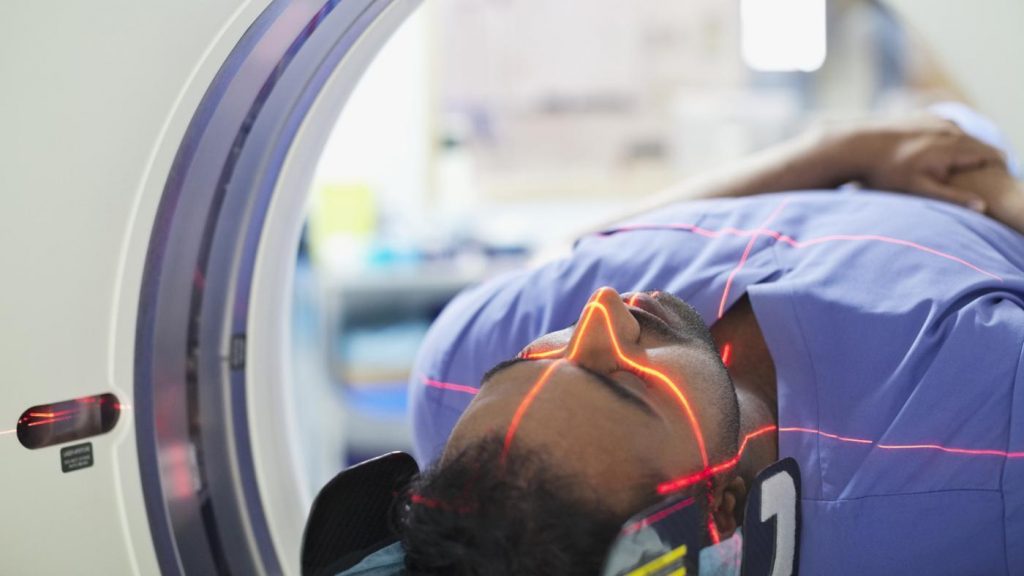15-Minute MRI Soon to be Possible?

Lying perfectly still for an hour in a magnetic resonance imaging machine (MRI) isn’t anyone’s idea of fun. But for some patient populations, such as those suffering from the tremors that come with Parkinson’s disease, it’s practically impossible.
Using a $2.1 million grant from the National Institute of Neurological Disorders and Stroke, a team of University of Arizona researchers led by Nan-Kuei Chen from the College of Engineering is creating faster MRI technologies to accommodate challenging patient populations, including stroke patients, individuals with Parkinson’s disease and children. Scan times will be reduced from 40-60 minutes to around 15 minutes – or even shorter if a patient’s condition necessitates it. In addition, scans will provide higher-resolution images with richer information, giving health care practitioners more information about the stage of a disease, and even allowing for earlier diagnosis of conditions like Parkinson’s.
The pre-motor stages of Parkinson’s, which can include rapid eye movement sleep behavior disorder and hyposmia, or a reduced sense of smell, often begin setting in 10-15 years before the disease is diagnosed. By the time of diagnosis, 60-70 percent of dopamine-releasing neurons are already damaged – dopamine deficiency is the cause of most Parkinson’s symptoms – and treatment options are limited.
“We want to address the boundaries of existing MRI protocol,” said Nan-Kuei Chen, principal investigator and associate professor in the UA Department of Biomedical Engineering. “With this research, MRI scans will be faster and higher quality and will produce richer information, so we can be better informed on the stage of disease or will even be able to see if there’s any brain signal abnormality before the disease is diagnosed. With earlier detection, we might be able to delay the disease’s progress.”
The technique is building upon the multiplexed sensitivity encoded MRI, known as MUSE, and diffusion tensor imaging technology developed by Chen, who is also a member of the UA BIO5 Institute. Enhanced MUSE advances the imaging modality in two key areas: It reduces motion artifact, or inconsistencies created in an image when the subject of a scan moves, and it incorporates multiple types of MRI data, such as information on iron levels, gray matter volume, and white matter connectivity.
Obtaining such high-resolution images can come at a cost. In order to gather enough data, the MRI machine must take long-exposure images, the equivalent of taking a photograph using low shutter speed to let in as much light as possible. However, a long exposure can mean introducing noise, or a grainy quality, into an image. To address this, enhanced MUSE includes a “denoising” process, which researchers have already found can reduce noise-related errors by up to 90 percent. Another trade-off for these high-resolution images is that they come out geometrically warped due to the asymmetric scanning pattern used by the equipment. This is problematic because doctors often advise treatments – including surgery, intervention and deep brain stimulus – based on the scans, so precision is key.
The result of all of this? A high-resolution image that’s free from motion-related blur, geometric distortion, and noise, all thanks to enhanced MUSE and the researchers behind it.
“By refining existing technologies to better inform the diagnosis of people suffering from neurologic disorders, Dr. Chen and his colleagues are a great example of the potential that lies at the nexus of technology and biology,” said UA President Robert C. Robbins. “To improve the quality of an MRI, while also cutting the time it takes to do the imaging, would be a major step forward for physicians and patients. The second aspect of this research, which will see whether this enhanced technique can help with earlier diagnosis, could mean earlier intervention for the people who suffer from these conditions. I look forward to following their progress, and seeing the contributions they will make in the field of biomedical engineering.”
In the first phase of the five-year project, researchers will test the new methods on healthy patients and then verify the accuracy of their results using a method called transcranial magnetic stimulation. They will evaluate and compare data from patients at high risk for Parkinson’s with those in the early and late stages of the disease. Researcher Ted Trouard also believes this research will push many other fields forward. Despite the continuous improvements of MRI technology, it would still be difficult to find a high-performing system with affordable price. Sound Imaging is your one-stop shop for all MRI system and accessories that are not only high-quality but also certified low-price. Please, feel free to visit our website to check all our products and accessories including the MRI Visors, MRI Stereo, MRI CCTV, and Bi-Directional.

